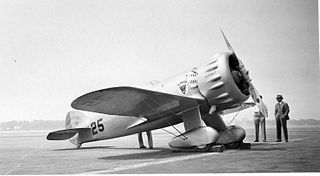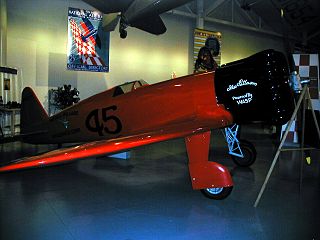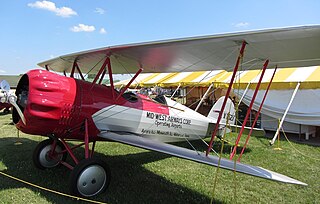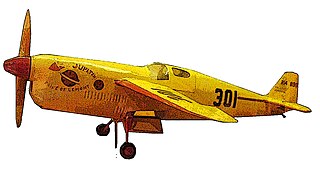
The Gee Bee Model R Super Sportster was a special-purpose racing aircraft made by Granville Brothers Aircraft of Springfield, Massachusetts at the now-abandoned Springfield Airport (Massachusetts). Gee Bee stands for Granville Brothers.

The National Air Races are a series of pylon and cross-country races that have taken place in the United States since 1920. The science of aviation, and the speed and reliability of aircraft and engines grew rapidly during this period; the National Air Races were both a proving ground and showcase for this.

The Wedell-Williams Model 44 is a racing aircraft, four examples of which were built in the United States in the early 1930s by the Wedell-Williams Air Service Corporation. It began as a rebuilding of the partnership's successful We-Will 1929 racer, but soon turned into a completely new racing monoplane aircraft, powered by a large radial engine. Model 44s became the dominant racers of the 1930s, setting innumerable records including setting a new world speed record in 1933.

The Wedell-Williams Model 45 was a racing aircraft built in the United States in 1933.

Great Lakes Aircraft Company is an aircraft manufacturer known for the 2T-1A Sport Trainer biplane. The company has a long history of building both private and military aircraft.

The Cessna CR-3 was a follow on racing aircraft to the Cessna CR-2 that raced in the 1932 National Air Races.

The Cessna GC-1 was an air racer built to compete in the Cirrus All American Air Derby in 1930.
The Cessna CR-2 was a mid-winged racing aircraft in the CR series of Cessna racers.

The Chester Jeep aka the Chester Special #1 was an air racer built by Art Chester for the 1932 National Air Races. The aircraft once held the world's speed record for aircraft at 237 mph (381 km/h).

John H. Livingston (1897–1974) was an American aviator and air race pilot of the 1920s and 1930s. Livingston placed first in 80 national air races.
The Swee' Pea was a series of three midget aircraft racers designed by Art Chester.

The Folkerts SK-2, also known as Speed King Two, "Toots" and "Miss Detroit" was a racer built for the 1936 National Air Races

Chief Oshkosha.k.a.Buster is a homebuilt racing plane designed to compete in the 1931 American Cirrus Races.

The Folkerts SK-3 a.k.a. "Jupiter, Pride of Lemont was the third in a series of air racers developed by Clayton Folkerts.

Clayton Folkerts (1897–1964) was an American aircraft designer.

The Howard DGA-3 "Pete", a.k.a. "Damned Good Airplane – 3", "Baker Special", and "Little Audrey" was the third aircraft built by Ben Howard, and the first in a series of racing aircraft. Howard claimed that the aircraft was so fast from his use of "Go Grease".

The Howard DGA-4 a.k.a. Mike, and DGA-5 a.k.a. Ike and "Miss Chevrolet" was the next in a series of racers from Ben Howard. He built two examples, "Mike" and "Ike", each with a different landing gear design.

The Nicholas-Beazley Pobjoy Special aka the Nicholas-Beazley Phantom I, aka the Wittman Phantom, aka the Flagg Phantom, aka the Reaver Special was a world record holding air racer of the 1930s

The Wedell-Williams Model 22 was a racing aircraft, two examples of which were built in the United States in the early 1930s by the Wedell-Williams Air Service Corporation. It was one of three early projects by aircraft designer Jimmy Wedell to create a racer and was built specifically to compete in the 1930 All-American Flying Derby from Buffalo to Detroit. It was a braced, low-wing monoplane originally powered by an inline Cirrus engine and equipped with fixed landing gear in large spats.

The Miles & Atwood Special is a racing aircraft developed during the interwar period


















